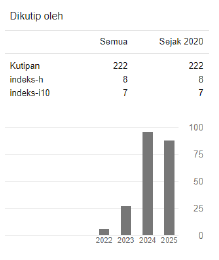An Analysis of Noun Phrase in the Indonesian Folklore Translated Into English “The Legend of Malin Kundang” On the Indonesian Folklore Website
 https://doi.org/10.54012/ijcer.v2i2.214
https://doi.org/10.54012/ijcer.v2i2.214
 Abstract views: 301
Abstract views: 301
 PDF downloads: 226
PDF downloads: 226
Keywords:
Analysis, Noun Phrase, Legend, Malin KundangAbstract
This research aims to delve into the intricate world of Noun Phrases in the English language, specifically within the Indonesian folklore text, “The Legend of Malin Kundang”, which has been translated into English. Using descriptive qualitative research, researchers sourced text from the Indonesian Folklore website. The enlightening findings of this research revealed a total of 85 Noun Phrases woven into the folklore text. Upon further analysis, thirteen structures emerged, each contributing to the richness and depth of these Noun Phrases. These structures include the combinations of “Article + Noun” (41.18%), “Possessive Adjective + Noun” (17.64%), “Noun + Noun” (14.11%), “Article + Adjective + Noun” (12.94%), “Article + Noun + of + Noun” (2.35%), “Adjective + Noun” (2.35%), “Article + Noun + Noun” (2.35%), “Possessive Adjective + Adjective + Noun” (1.18%), “Article + Pronoun + of + Noun + Noun” (1.18%), “Article + Pronoun + of + Noun” (1.18%), “Pronoun + Noun” (1.18%), “Preposition + Article + Adjective + Noun” (1.18%), and “Article + Adjective + Noun + of + Noun” (1.18%).
Downloads
References
Chaer, A, Linguistik Umum. Jakarta: Rineka Cipta, 2007.
Davis, Katie, Sentence Combining and Paragraph Construction. New York: Macmillan Publisher Co, Inc, 2015.
Manurung, Nomita. “An Error Analysis of Grammatical Features in Report Text by The Eleventh Grade Students of Accounting Major at Smk N 1 Jorlang Hataran”, The Explora 7.1: 38-48, 2021.
Ningsih, Rahmi Yulia, and Chandra Kurniawan Wiharja. “Noun Phrase in Bahasa Indonesia”, Humaniora 8.1: 79-88, 2017.
Safitri, Riski, et al. “An Error Analysis In Arranging Structure Of Noun Phrase Made By The Eleventh-Grade Students Of SMA N 2 Muaro Jambi”, Journal on Education 6.1: 3858-3867, 2023.
Saragih, Dhea. “THE USE OF DICTATION STRATEGY IN TEACHING LISTENING”, TRANSFORMATIONAL LANGUAGE, LITERATURE, AND TECHNOLOGY OVERVIEW IN LEARNING (TRANSTOOL) 1.2: 1-10, 2022.
Saragih, Dhea, et al. “An Analysis of Types of English Sentences in English Folklore “Jack and the Beanstalk” from American Literature Website”, International Journal Corner of Educational Research 2.2: 57-63, 2023.
Sudrajat, Didi, and Marrissa Aprillia Novitasari. “An Analysis on Noun Phrases in Reading Texts of English Textbook for Eleventh Grade Students of senior High School”, Intelegensia: Jurnal Pendidikan dan Pembelajaran, 3.2: 25-34 (2018).
Sugiyono, Metode Penelitian Kuantitatif. Bandung: Alfabeta, 2018.
Y. M. Lingga and W. A. A. Sur, “The Acquisition of English Sentences By Children of Four And Five Years Old”, JETALL, 2.2: 84-94, 2019.
Downloads
Published
How to Cite
Issue
Section
License
Copyright (c) 2023 Parida Hutapea, Winda Oktavia Sipangkar, Glorya Natalia Rohani Napitupulu, Ika Dianda Silalahi, Lustriyani Sidabalok

This work is licensed under a Creative Commons Attribution-ShareAlike 4.0 International License.









